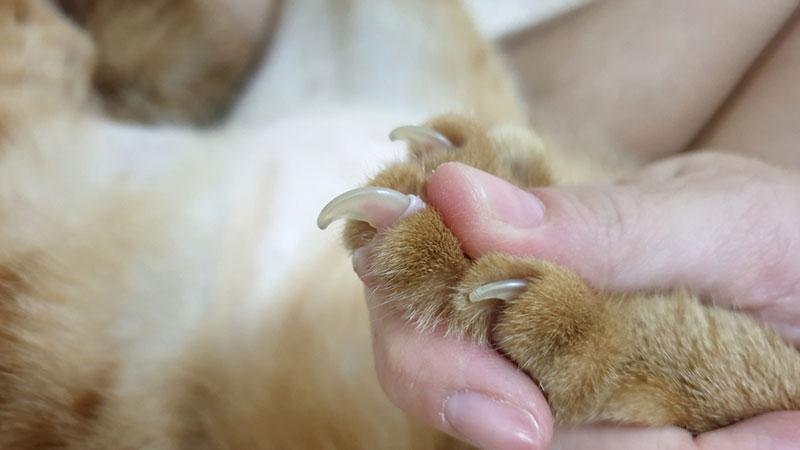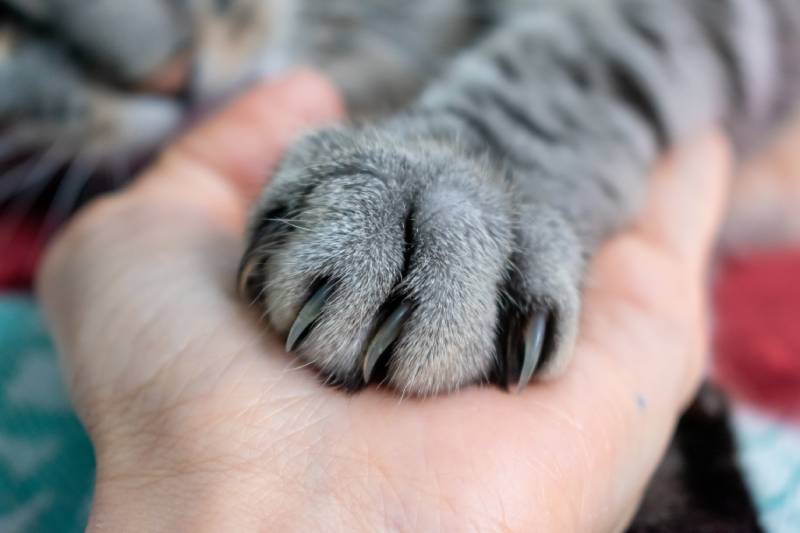VET APPROVED

The information is current and up-to-date in accordance with the latest veterinarian research.
Learn more »Click to Skip Ahead
Declawing cats, or onychectomy, is a procedure that involves the surgical removal of a cat’s claw and last phalanx of each toe, where the claw grows. Some cat owners elect for the procedure in order to prevent their cats from damaging their furniture, curtains, and other parts of their homes. However, since the process involves an unnecessary amputation of a cat’s body part, it is understandably increasingly unpopular, causing many people to wonder if it is illegal.
The short answer is that while it’s not illegal across the entire country, some U.S. states and many cities have laws against declawing cats. Keep reading as we discuss where it is an illegal practice. We also list respectful alternatives to declawing or ways to redirect your cat’s undesired scratching.

When Did the Declawing Practice Get Started?
In the mid-20th century, while controversial, declawing gained popularity in the United States to safeguard indoor environments and prevent scratches on household items. However, attitudes changed as more pet owners became aware of animal rights and welfare. Scratching is part of a cat’s natural behavior. Declawed cats are unethically deprived of displaying this marking behavior and of keeping their claws in good condition.

What Is Cat Declawing?
Declawing is a surgical procedure involving amputating a cat’s third phalanx, equivalent to amputating a human’s finger at the last joint, removing the nail and the bone from where it grows. Unless there is a medical indication to be performed, such as a tumor removal in this area, the process is considered unethical and can cause physical pain and potential long-term consequences. Declawing can cause behavioral issues, affecting your pet’s well-being.
Cats rely on their claws for various natural behaviors, including stretching, climbing, and scratching. Declawing inhibits these behaviors, potentially leading to physical problems such as back pain, arthritis, and behavioral distress. Furthermore, declawed cats lose a crucial defense mechanism, rendering them more vulnerable.

The Legal Status of Declawing Cats
Global Status
The legality of declawing cats varies significantly worldwide. Some countries and regions have taken a strong stance against the practice due to its ethical concerns, while others have limited or no regulations. You cannot declaw cats in many parts of the world including Australia, New Zealand, Brazil, and most European countries such as the U.K., Belgium, Bulgaria, Finland, France, Germany, Greece, Italy, Sweden, Switzerland, and Spain, among others. Canada also prevents the declawing of cats in eight out of 10 provinces.

American Status
While declawing was once quite common in the U.S., its popularity has declined since the City of West Hollywood banned it in 2003, and several other California cities adopted the ban soon after, including Berkeley, Beverly Hills, Burbank, Culver City, Los Angeles, San Francisco, and Santa Monica. Since then, New York and Maryland, and, very recently, Virginia have passed legislation to ban declawing throughout the entire state except for specific medical reasons, and several other states are working on passing the legislation, including New Jersey, Massachusetts, and Florida.
Several other cities and municipalities across the United States also ban it, including Austin, Denver, Pittsburgh, Allentown, and Madison. The entire county of St. Louis bans it, including the city.
The laws are continuously changing as more people become aware of the problems with declawing, so it’s likely to become illegal in more places. Some veterinarians may also refuse to declaw a cat even if it is still legal in their area.

Alternatives to Declawing
Scratching Posts
Commercial scratching posts are ideal for allowing your cat to display their natural instinctual behavior of stretching and scratching while preventing them from damaging your belongings. Place several around your home, and if you see your cat scratching at the furniture, guide them over to the scratching post. This will redirect their behavior, and you can even give them a treat when they catch on, to positively reinforce the behavior and encourage them to repeat it. Adding catnip to the posts can also help attract your cats.
We're big fans of using cardboard as a material for cat scratchers, which is why it's no surprise that our favorite scratcher, the Hepper Hi-Lo Cat Scratcher, is made with cardboard. With a durable, sturdy, and modern-looking birch plywood frame, this scratcher is designed to make both cats and their hoomans happy. You can set it up in three different ways, too, to keep your cat fit and entertained. Click here to learn more.
At PangoVet, we've admired Hepper for many years, and decided to take a controlling ownership interest so that we could benefit from the outstanding designs of this cool cat company!
Scratching Pads
Scratching pads are similar to scratching posts but lay flat on the ground. These are usually less expensive and some cats prefer them. The downside is that they are often cardboard and can make a mess as your cat scratches them.
Nail Trimming
Trimming your cat’s nails with a cat-specific nail clipper is an excellent way to keep your cat’s claws in good condition. You can book a consultation with a vet or visit a professional groomer if you don’t know how to trim your cat’s nails.
Scratching is a normal cat behavior, but that doesn't mean you have to sacrifice your belongings! The right pair of nail clippers can help you keep your cat's nails perfectly trimmed. We recommend Hepper's Cat Nail Clipper Set, which includes two different sizes of stainless steel clippers, a built-in nail file, and a convenient storage pouch. You'll love the comfortable handles, precision blades, and protective safety guard.
At PangoVet, we've admired Hepper for many years, and decided to take a controlling ownership interest so that we could benefit from the outstanding designs of this cool cat company!
Nail Caps
Nail caps are designed to cover your cat’s nails to prevent them from damaging surfaces when scratching. This option is controversial because most cats don’t tolerate them and they can’t display their normal behaviors while wearing them.

Summary
Declawing is illegal in several cities and states in the United States and many countries worldwide. Many states also have legislation in the works to ban it, including Florida and New Jersey. Since this legislation is reacting to more people becoming aware of the problems with declawing, it’s likely to become illegal in many more places in the coming years. It’s also likely that some veterinarians will refuse to do the procedure or offer respectful ways to redirect the scratching so that you can change your mind in areas where it’s legal.
Training your cat to use a scratching post or pad using positive reinforcement can be effective at helping your cat stop scratching your walls or furniture. Interactive toys can also help tire them out and prevent boredom, and trimming the nails might reduce their urge to scratch and make the nails less destructive.
- See also: Snakes That Don’t Eat Mice Or Rodents
- https://www.npr.org/2019/07/23/744436827/cats-can-keep-their-claws-new-york-bans-declawing
- https://www.rd.com/article/cat-declawing/
- https://todaysveterinarynurse.com/ethics-welfare/poll-should-the-u-s-ban-cat-declawing/
- https://icatcare.org/declawing-in-cats-why-it-is-unacceptable/
- https://www.peta.org/blog/where-declawing-is-illegal/
- https://www.wvva.com/2024/04/19/gov-youngkin-signs-bill-banning-cat-declawing-virginia/
Featured Image Credit: Kunitsa Yana, Shutterstock













